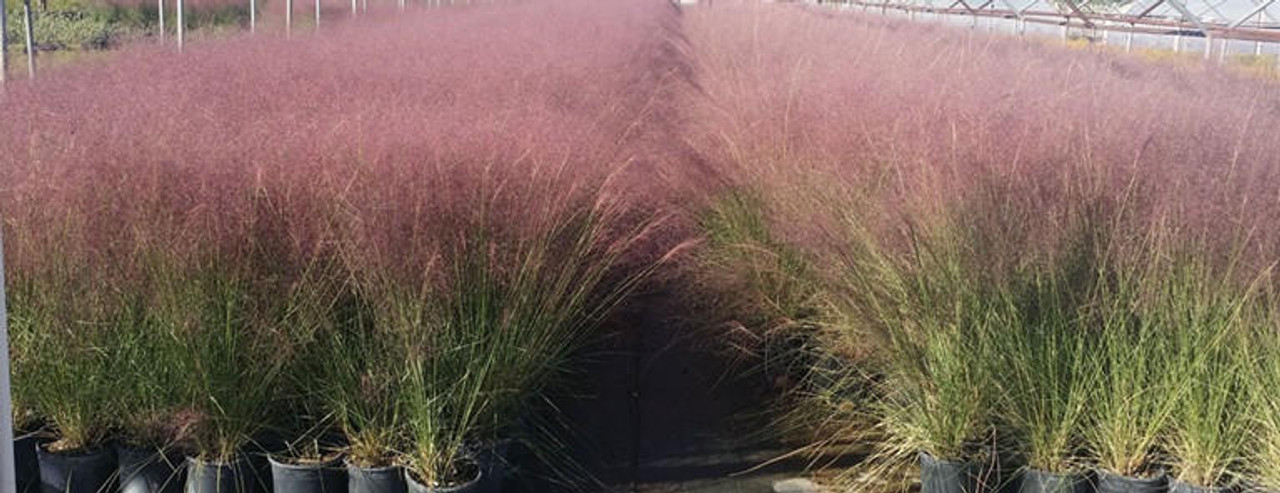Product Description
Muhlenbergia capillaris (4) 1-gallons
Common Name: pink muhlygrass
Type: Ornamental grass
Muhlenbergia capillaris, commonly called pink muhlygrass or pink hair grass, is a clump-forming, warm season, perennial grass that is noted for its attractive summer foliage and spectacular clouds of fall flowers. Best grown in sandy or rocky, dry to medium moisture, well-drained soils in full sun to light shade. Best in full sun. Regular water during the first growing season helps establish a deep, extensive root system. Tolerant of heat, humidity, and drought; does not tolerate wet winters. Does not spread by rhizomes.
Native to prairies, pine barrens, and open woodlands from Massachusetts to Kansas south to Florida and Texas. Glossy, wiry, thread-like, dark green leaves and stems form an attractive basal clump. It is the fall flowering, however, that most distinguishes this grass. Masses of airy, open, loosely branched inflorescences (each to 12” long) in pink to pinkish-red float above the foliage in a lengthy fall bloom. Tan seed plumes remain attractive in winter. Plants typically grow to 3’ tall x 3’ wide when in flower.
Family: Poaceae
Native Range: Western-central United States
Zone: 5 to 9
Height: 2.00 to 3.00 feet
Spread: 2.00 to 3.00 feet
Bloom Time: September to November
Bloom Description: Pink to pinkish red
Full sun to part shade
Water: Dry to medium
Maintenance: Low
Muhlenbergia capillaris, commonly known as Pink Muhly Grass, is a stunning ornamental grass prized for its airy clouds of pink to purplish-red flowers that appear in the fall. It is a popular choice for adding texture, movement, and a touch of whimsy to gardens and landscapes.
Key Features:
- Showy inflorescences: The most striking feature is the abundance of delicate, feathery flower plumes that rise above the foliage in autumn, creating a cloud-like effect. The color ranges from soft pink to deep pinkish-red, depending on the light and the cultivar.
- Fine-textured foliage: The basal foliage consists of slender, wiry, dark green leaves that form an attractive mound.
- Clump-forming habit: Grows in a dense, clumping form, typically reaching 2-3 feet tall and wide.
- Native grass: It is native to North America, occurring naturally in prairies, open woodlands, and pine barrens.
- Low maintenance: Once established, it requires minimal care.
- Attracts wildlife: Provides food and shelter for birds and other small wildlife.
- Drought tolerant: Can withstand periods of dryness once established.
Uses in the Garden:
- Ornamental grass: Adds texture, movement, and color to borders, meadows, and naturalized areas.
- Mass plantings: Creates a dramatic display when planted in large drifts.
- Specimen plant: Can be used as a focal point in the garden.
- Erosion control: Helps to stabilize slopes and prevent erosion.
- Wildlife gardens: Provides habitat for birds and other beneficial creatures.
- Cut flower arrangements: The feathery plumes can be used in fresh or dried flower arrangements.
Growing Tips:
- Sunlight: Plant in full sun to part shade. Full sun promotes the best flowering and color.
- Soil: Prefers well-drained soil but tolerates a variety of soil types, including sandy or rocky soils.
- Watering: Water regularly until established, then only during prolonged dry periods.
- Pruning: Cut back the foliage to about 3-4 inches above the ground in late winter or early spring before new growth emerges.
Muhlenbergia capillaris is a beautiful and versatile ornamental grass that adds a touch of magic to the fall garden. Its cloud-like blooms, fine-textured foliage, and adaptability make it a popular choice for gardeners seeking low-maintenance beauty and ecological benefits.
Tolerate: Drought, Black Walnut, Air Pollution, Slopes or banks, cut-flower arrangements, groundcover, Deer Resistant, Winter Interest, Heat Tolerant, Salt Tolerant
(4) 1-gallon containers ready to plant, plants may be trimmed for shipping,
Other Details
The most important part of the plant is its root system. Healthy roots are the foundation of a healthy, vibrant plant. The type of plug container used is based on the specific needs of the plants. Perennials offered as bare root traditionally perform better when planted as bare root.Planted in a specialized mix, potted plants have well established root systems. Top growth stage will vary depending on the current life cycle and time of year when shipped. In Winter and early Spring dormant plants may be shipped. Dormant plants may be planted right away, even before the last frost date.
Most bare root varieties are field grown for at least one season, though Hemerocallis and Hosta are grown for two seasons. The bulk of the soil is removed during the harvesting process and the tops of most varieties are trimmed back to the crown. They are graded, packed in shredded aspen or sphagnum moss and stored in freezers until ready to be shipped.
See our Container Sizes and Bare Root Perennials pages for more information.
Plant information and care is provided in the Overview section, Plant Genus Page and general information is provided in the Planting Care & Guides. Additional questions can be asked on each Plant page.
Plant Spacing: Using the maximum mature spread or width of a plant to guide spacing, ensures space to grow to full size. To fill an area sooner, plant them closer together. Just remember, future thinning or transplanting may be needed.
Water: Keep a close eye on newly planted perennials, especially throughout the first growing year. Most early plant loss is due to too much or too little water!





